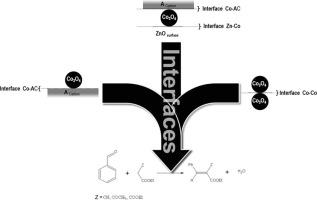Journal of Catalysis ( IF 7.3 ) Pub Date : 2022-10-12 , DOI: 10.1016/j.jcat.2022.09.034 Seila Martín-García , Fernando Rubio-Marcos , Vanesa Calvino-Casilda

|
The preparation of heterogeneous catalysts is decisive to the development of catalytic processes that are environmentally acceptable. Therefore, the methodology used in the preparation of such catalysts is a key factor in the development of high catalytic activity and with concern to environmental value. Herein, we report the design of catalysts by dispersing nanoparticles of cobalt oxide (Co3O4) on micrometric supports of zinc oxide (ZnO) and activated carbon (AC) using a fast and green methodology free of waste and solvents and with a low-energy consumption. In particular, the partial reaction that takes place, at room temperature, between both metal oxides and between these oxides and AC, due to proximity and diffusion effects of the corresponding materials, results in the formation of different interfaces (ZnCo, ZnAC, CoAC Co-Co). Specifically, such interfaces are new reactive surfaces that lead to very interesting and innovative properties. Thus, depending on its application, it is possible to control and modify the catalytic properties (activity / conversion / selectivity) of a solid by tuning surface and interface. This fact is proved in the model reaction of Knoevenagel condensation between aldehydes and malonic esters. Therefore, our results prove that controlling the interfaces is a feasible way to achieve in the Knoevenagel condensation, which is a reaction widely used in the formation of C–C bonds for the organic synthesis of important intermediates and final products.
中文翻译:

用于CC键形成反应的分级组织金属负载碳催化剂
多相催化剂的制备对于环境可接受的催化工艺的发展是决定性的。因此,用于制备此类催化剂的方法是开发高催化活性和环境价值的关键因素。在此,我们报道了通过分散氧化钴纳米颗粒(Co 3 O 4) 在氧化锌 (ZnO) 和活性炭 (AC) 的微米载体上使用一种快速、绿色的方法,不含废物和溶剂,并且能耗低。特别是,在室温下,两种金属氧化物之间以及这些氧化物与 AC 之间发生的部分反应,由于相应材料的接近和扩散效应,导致形成不同的界面(ZnCo、ZnAC、CoAC Co -Co)。具体来说,此类界面是新的反应性表面,可带来非常有趣和创新的特性。因此,根据其应用,可以通过调整表面和界面来控制和修改固体的催化性能(活性/转化率/选择性)。这一事实在醛和丙二酸酯之间的 Knoevenagel 缩合模型反应中得到证明。所以,



























 京公网安备 11010802027423号
京公网安备 11010802027423号